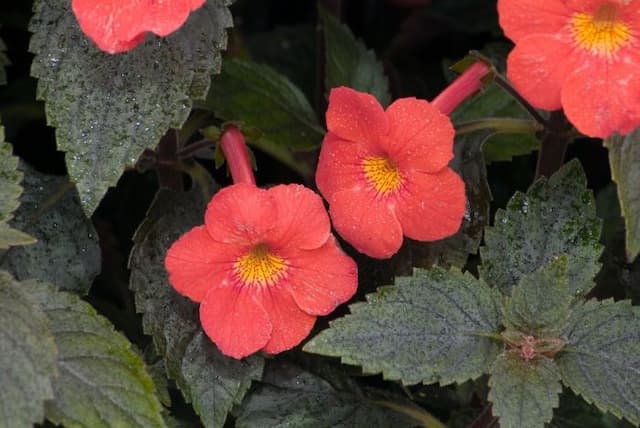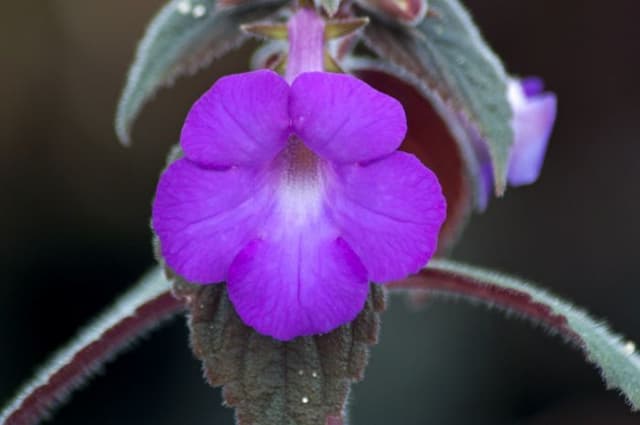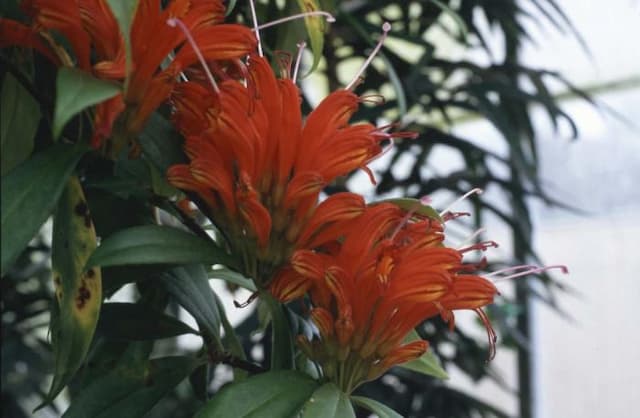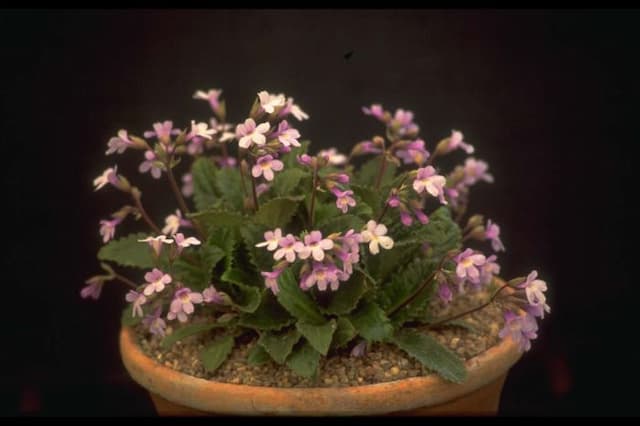Cape primrose 'Watermelon Wine' Streptocarpus 'Watermelon Wine'

ABOUT
A tender, evergreen perennial with mid- to dark green, strap-shaped leaves. Flowers borne over a long season are a dark pinkish-red with deeper red markings on the lower lobes
About this plant
 Names
NamesFamily
Gesneriaceae
Synonyms
Cape Primrose, African Violet Cousin
Common names
Streptocarpus 'Watermelon Wine'
 Characteristics
CharacteristicsLife cycle
Perennials
Foliage type
Evergreen
Color of leaves
Green
Flower color
Pink
Height
1 foot (30 cm)
Spread
1 foot (30 cm)
Plant type
Herb
Hardiness zones
10
Native area
Africa
Benefits
 General Benefits
General Benefits- Aesthetic Appeal: Adds vibrant color to indoor spaces with its striking red-pink and green patterned leaves.
- Easy Maintenance: Requires minimal care, making it suitable for beginners or those with a busy lifestyle.
- Habitat Enrichment: Invites biodiversity by providing habitat for small insects when grown outdoors.
- Mood Enhancer: The presence of flowering plants like Streptocarpus can boost mood and create a calming environment.
- Long Blooming Period: Offers a lengthy flowering season which can last several months with the right care.
- Compact Growth: Ideal for small spaces due to its compact size and contained growth habit.
- Gift Potential: Often sought after as a thoughtful and beautiful gift for plant enthusiasts or for special occasions.
 Medical Properties
Medical PropertiesThis plant is not used for medical purposes.
 Air-purifying Qualities
Air-purifying QualitiesThis plant is not specifically known for air purifying qualities.
 Other Uses
Other Uses- Photography Subject: Due to its attractive foliage and blooms resembling slices of watermelon, the Streptocarpus can be an interesting subject for botanical photographers and artists.
- Educational Tool: Horticulture teachers may use the Streptocarpus to demonstrate hybridization techniques and explain floral anatomy to students.
- Relaxation Aid: The process of caring for and watching the plant grow can be used as a therapeutic activity to help reduce stress levels and provide a sense of accomplishment.
- Seasonal Decoration: The colorful blossoms of the Streptocarpus make it an attractive option for decorating during spring and summer events.
- Gift Plant: Its unique appearance and relatively easy care make the Streptocarpus a suitable gift for plant enthusiasts or as a housewarming present.
- Insect Habitat: When kept outdoors, Streptocarpus plants can provide nectar and become a temporary habitat for beneficial insects.
- Study Subject for Botany: The Streptocarpus can be a study subject for botanists who are interested in plant morphology or the Gesneriaceae family specifically.
- Collectibles: Some people enjoy collecting various types of Streptocarpus, including 'Watermelon Wine', as a hobby.
- Color Contrast in Landscaping: The distinctive coloring of the Streptocarpus can be used to create visual contrast when paired with green foliage plants in garden design.
- Container Gardening: Ideal for growing in containers, Streptocarpus adds variety to balconies or patios where ground planting isn't possible.
Interesting Facts
 Feng Shui
Feng ShuiThe Cape primrose is not used in Feng Shui practice.
 Zodiac Sign Compitability
Zodiac Sign CompitabilityThe Cape primrose is not used in astrology practice.
 Plant Symbolism
Plant Symbolism- Endurance and Survival: Streptocarpus, also known as Cape Primrose, generally symbolizes endurance and the ability to survive with minimal water, as it can retain moisture and thrive even in dry conditions.
- Evergreen Beauty: The evergreen nature of Cape Primrose represents timeless beauty and longevity.
- New Beginnings: The flower is often associated with new beginnings due to its habit of continuous blooming throughout its growing season.
- Adaptability: Cape Primrose's ability to adapt to various light conditions symbolizes flexibility and the ability to thrive in different environments.
 Water
WaterCape primrose requires consistent moisture without becoming waterlogged. Typically, it should be watered when the top inch of soil feels dry to the touch. Depending on the environment, this might be once a week. It's best to water this plant from the bottom by placing the pot in a tray of water and allowing it to soak up moisture for about 30 minutes. Ensure the plant receives approximately 8-16 onzes of water during each watering session, adjusting as necessary for your home's humidity and temperature.
 Light
LightCape primrose thrives in bright, indirect sunlight. It should be placed in a location where it receives plenty of light but is shielded from the harsh midday sun. An east-facing window where the plant can get gentle morning sun or a north-facing window is typically ideal for this plant.
 Temperature
TemperatureCape primrose prefers temperatures between 65-75°F and can struggle in conditions outside of 60-80°F. The ideal temperature for promoting growth and flowering is within this range. It's important to protect the plant from drafts and extreme temperature fluctuations to keep it healthy.
 Pruning
PruningPruning Cape primrose is important to encourage bushier growth and more blooms. Pinch off spent flowers and any yellowing leaves to maintain the plant's appearance and promote health. The best time to prune is after a flush of blooms when you can see which stems are spent.
 Cleaning
CleaningAs needed
 Soil
SoilFor a Cape Primrose, use a light, fast-draining mix like one part peat moss, one part perlite, and one part loamy soil. Aim for a soil pH between 5.5 and 6.5.
 Repotting
RepottingCape Primroses should be repotted once a year or when they outgrow their pots, best done in spring or early summer.
 Humidity & Misting
Humidity & MistingCape Primroses prefer a moderate to high humidity level, ideally between 50-60% for optimal growth.
 Suitable locations
Suitable locationsIndoor
Place Cape Primroses in bright, indirect light indoors, avoiding direct sun.
Outdoor
Ensure Cape Primroses are in shaded spots outdoors, protected from direct sunlight.
Hardiness zone
10-11 USDA
 Life cycle
Life cycleStreptocarpus 'Watermelon Wine', commonly known as Cape primrose, starts its life cycle when seeds germinate in warm, moist soil. After germination, seedlings begin to grow, developing a rosette of elongated leaves. As the plant matures, it forms a cluster of leaves and starts to produce flowering stems. Flowers, resembling watermelon with their pink and green hues, bloom predominantly in spring and summer but can appear throughout the year in favorable indoor conditions. After pollination, the plant sets seed, which can be collected and sown to produce new plants. Finally, although Cape primrose is a perennial, it may become less vigorous after a few years, at which point it can be propagated by leaf cuttings to refresh the stock.
 Propogation
PropogationPropogation time
Spring to Summer
Propogation: Streptocarpus 'Watermelon Wine', commonly known as Cape Primrose, can be effectively propagated by leaf cuttings, a method frequently used for this species. The best time to propagate Cape Primrose by leaf cuttings is during the growing season, typically from late spring to early fall. You take a healthy leaf and cut it into sections, each with a vein. The leaf sections are then placed vein-side down in a moist potting mix or a propagation medium. It is important to maintain a warm and humid environment, using a plastic cover or propagator to create a mini-greenhouse effect, while ensuring that the soil remains moist but not soggy. Roots usually develop in a few weeks, after which individual plants can be potted up.









